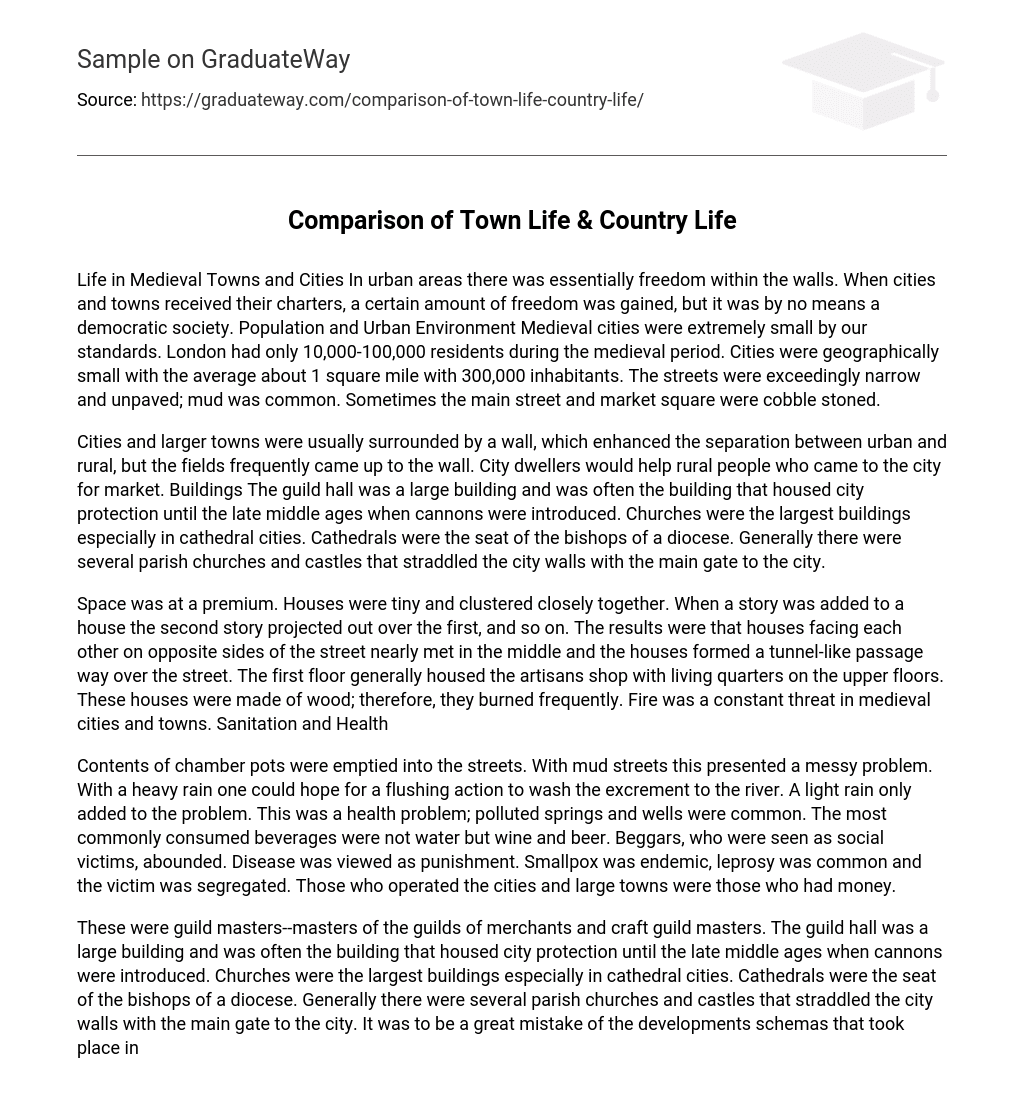Life in Medieval Towns and Cities In urban areas there was essentially freedom within the walls. When cities and towns received their charters, a certain amount of freedom was gained, but it was by no means a democratic society. Population and Urban Environment Medieval cities were extremely small by our standards. London had only 10,000-100,000 residents during the medieval period. Cities were geographically small with the average about 1 square mile with 300,000 inhabitants. The streets were exceedingly narrow and unpaved; mud was common. Sometimes the main street and market square were cobble stoned.
Cities and larger towns were usually surrounded by a wall, which enhanced the separation between urban and rural, but the fields frequently came up to the wall. City dwellers would help rural people who came to the city for market. Buildings The guild hall was a large building and was often the building that housed city protection until the late middle ages when cannons were introduced. Churches were the largest buildings especially in cathedral cities. Cathedrals were the seat of the bishops of a diocese. Generally there were several parish churches and castles that straddled the city walls with the main gate to the city.
Space was at a premium. Houses were tiny and clustered closely together. When a story was added to a house the second story projected out over the first, and so on. The results were that houses facing each other on opposite sides of the street nearly met in the middle and the houses formed a tunnel-like passage way over the street. The first floor generally housed the artisans shop with living quarters on the upper floors. These houses were made of wood; therefore, they burned frequently. Fire was a constant threat in medieval cities and towns. Sanitation and Health
Contents of chamber pots were emptied into the streets. With mud streets this presented a messy problem. With a heavy rain one could hope for a flushing action to wash the excrement to the river. A light rain only added to the problem. This was a health problem; polluted springs and wells were common. The most commonly consumed beverages were not water but wine and beer. Beggars, who were seen as social victims, abounded. Disease was viewed as punishment. Smallpox was endemic, leprosy was common and the victim was segregated. Those who operated the cities and large towns were those who had money.
These were guild masters–masters of the guilds of merchants and craft guild masters. The guild hall was a large building and was often the building that housed city protection until the late middle ages when cannons were introduced. Churches were the largest buildings especially in cathedral cities. Cathedrals were the seat of the bishops of a diocese. Generally there were several parish churches and castles that straddled the city walls with the main gate to the city. It was to be a great mistake of the developments schemas that took place in the country As because of this many trees were cut down… roads were widened [pic][pic][pic] pic][pic][pic] Space was at a premium. Houses were tiny and clustered closely together. When a story was added to a house the second story projected out over the first, and so on. The results were that houses facing each other on opposite sides of the street nearly met in the middle and the houses formed a tunnel-like passage way over the street. The first floor generally housed the artisans shop with living quarters on the upper floors. These houses were made of wood; therefore, they burned frequently. Fire was a constant threat in medieval cities and towns. Sanitation and Health
Contents of chamber pots were emptied into the streets. With mud streets this presented a messy problem. With a heavy rain one could hope for a flushing action to wash the excrement to the river. A light rain only added to the problem. This was a health problem; polluted springs and wells were common. The most commonly consumed beverages were not water but wine and beer. Beggars, who were seen as social victims, abounded. Disease was viewed as punishment. Smallpox was endemic, leprosy was common and the victim was segregated. Those who operated the cities and large towns were those who had money.
These were guild masters–masters of the guilds of merchants and craft guild masters. Contents of chamber pots were emptied into the streets. With mud streets this presented a messy problem. With a heavy rain one could hope for a flushing action to wash the excrement to the river. A light rain only added to the problem. This was a health problem; polluted springs and wells were common. The most commonly consumed beverages were not water but wine and beer. Beggars, who were seen as social victims, abounded. Disease was viewed as punishment. Smallpox was endemic, leprosy was common and the victim was segregated.





